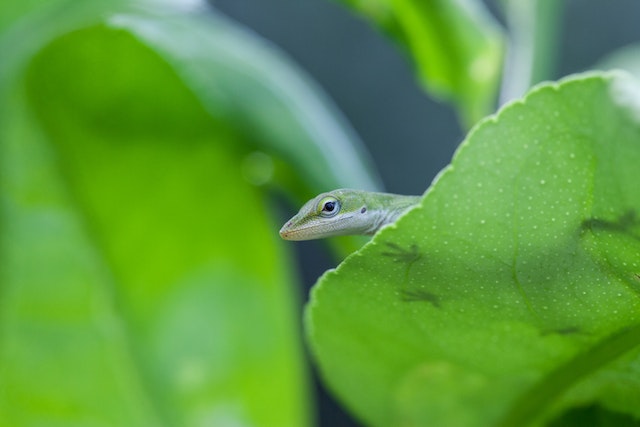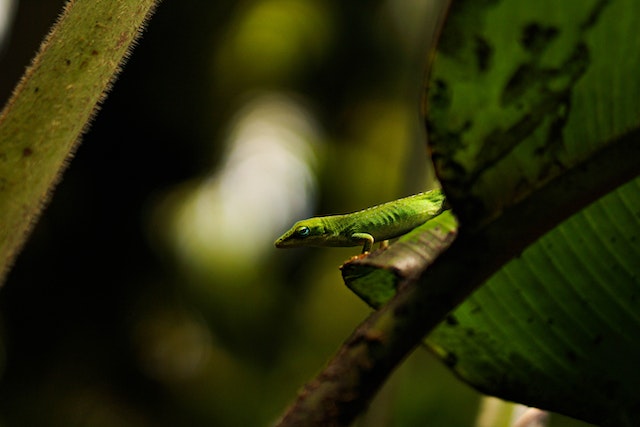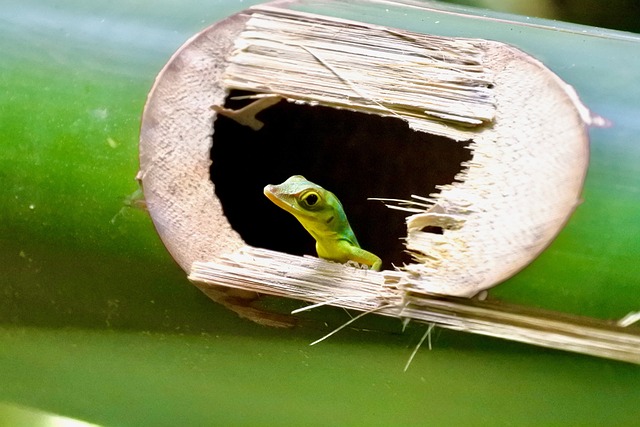Wondering what it means when your green anole goes full brown?
Or how about when it gets milky white?
Did you ever see it turn yellow?
Green anoles are hardly ever just “green.”
While you may see these lizards predominantly green, they can instantly change their color within seconds right before your eyes.
Color changes are triggered by a variety of factors, namely stress levels, hunger, and photo exposure (sunlight levels).
They’ll also change colors when they feel threatened by other anoles or potential predators.
In this article, we’ll talk about why they change colors and what the colors mean.
Table of Contents
Why do anoles change colors?
That’s like asking “why do you cross your arms” or “why do you frown?”
Do you do it subconsciously? At least most of the time? Or is it a triggered response?
Similar to how a cat or dog can display their mood through their body language, green anoles can do the same through their clingy, one-way skin and sticky feet that give them their remarkable agility to climb.
For example, when your anole is happily basking in the heat, it’s bright green and just relaxing like nobody’s business.
But once you put your hand in the tank, it quickly shifts to that dark brown or blackish color.
This is a reaction to the environment (your hand) which is causing a marked increase in stress, which then changes their color.
What is the best explanation for the change in green anoles?
They react to their environment, threats, or stress. Light, temperature, and humidity all play a role in their color state.
There’s no evidence if anoles can control their current color state, or if it’s an implicit reactive event that just happens instantaneously based on their mood.
Green anoles have pigment (melanin) in their skin. They have 3 total colors: yellow, blue, and brown.
The colors you see are rendered by a combination of the different colors, just like how your old school CRT TV colors are made from 3 primary colors (red green blue, or “RGB”).
We’ll discuss the various colors you may see your anole morph into and what they mean.
What colors can anoles change to?


There are 5 primary colors green anoles can change to:
- Green
- Brown
- White
- Black
- Brown
- Gray
Depending on the type of anole, the colors you’ll see will vary.
For most people that see anoles in the wild (Florida, California, Nevada, Arizona, Texas, etc.), you’ll be encountering the green anole or brown anole.
Then you also have other special anoles that can be red, orange, or even hybrids.
But these are far less common so we won’t go into too much detail about them because not many people keep them captive.
Some other colors include orange and red. You can really find an anole for every single color out there, but it’s too bad you can’t keep them all as pets!
Green anole color change meanings


Note that these are general color meanings. They don’t describe all possible reasons why your lizard may be changed to “that” color.
If you’re ever unsure about your anole’s situation, consult a vet for professional advice.
White
When your anole turns white, it means that he’s about to shed.
Green anoles will shed their skin in cycles- usually every 4-6 weeks.
The time it takes depends on environmental variables like humidity, food availability, light availability, water, temperature, and the anole itself. It turns a translucent white before it sheds its skin slowly.
Do NOT try to remove the skin, even if it seems stuck on it. It’ll come off on its own. You may notice your anole acting slightly differently during the shedding cycle.
This is normal so you have nothing to worry about. As your lizard gets closer to shedding, it’ll turn more whitish.
Some parts of it may be nearly solid white while others are more patchy.
Yellow
Yellow isn’t a permanent color. You’ll only catch a glimpse or two when the anole is shifting colors from green to brown or vice versa.
In some lighting, your lizard can look yellow. But it’s not something that either green or brown anoles can exhibit for extended periods.
There are yellow anoles (aka yellow chinned anoles or Anolis gundlachi). These are yellow as their default color.
They’re usually found in forested regions. A. gundlachi isn’t kept as a pet in captivity.
But those that aren’t as experienced with lizards, may mistake them for green anoles, which can lead to confusion because they think that yellow is a natural state that green anoles can change into.
Pigment issues can result in green anoles looking more lemony and yellow though, especially in the right lighting.
Brown
Brown is the most common color other than green for these reptiles.
While brown often signifies that the lizard is under duress or unhappy, it can also mean that it’s hiding or camouflaging from potential predators/threats.
The anole will remind brown until the threat is gone. This includes other anoles, reptiles, cats, dogs, birds, and even you!
You’ll likely see your anole hide or stay in one spot defensively while keeping a brown tone. If there are no threats present, it may be due to a lack of sunlight, too hot or cold temps, or humidity problems.
Once the issue is resolved, it should return to that pretty lime-green coloration. Cooler or moist environments often turn them brownish.
It can also signify a change in activity.
When anoles are active and happy, they’re bright green.
When they reduce their activity, they turn brown. This may happen when they sleep at night too.
One important thing to note: If you have a brown anole, brown is its natural state. They can only switch from brown to gray to black, but never to green.
Black
If your anole is turning black, it’s severely stressed. You should do a complete teardown of its tank and clean everything.
Remove the substrate so it’s a bare tank to get rid of any pathogens in the substrate.
If you have a water bowl, take it out and completely sterilize it. Then refill with distilled water or just leave it out.
They don’t need water bowls as long as you continually mist the tank. Water bowls harbor a ton of bacteria and viruses if they’re not regularly cleaned.
Double-check the ambient temperature and humidity. Ensure that the basking area is hot enough with proper UVB lighting. A hide should always be available to your lizard.
If you have an incubation or quarantine tank, consider transferring the anole there if it’s still black.
There could be an issue with the main tank. A black anole may switch to brown intermittently depending on temperature, lighting, mood, and environment.
For brown anoles, they may switch to black or brown depending on mood.
Gray
Gray is more closely associated with brown anoles rather than green anoles.
Since brown anoles can’t change to green, they change to black or gray when frightened, stressed, or for camouflage. You won’t see green anoles turn gray.
Green
Green is the classic green anole color!
If you see your lizard in this gorgeous shade of lime to dark green, it’s likely to be happy and you’re doing everything well.
This is the color you most commonly encounter when you see anoles in the wild.
The green color is associated with activity, so your lizard may be jumping from branch to branch, hunting, foraging, or just basking.
If it was previously brown and you made a change so that it’s now suddenly green, you now know what irks your anole.
Getting it to that lime green state is key to making your anole happy.
Brown vs. green? What do these colors really mean?
(No rhyme intended.)
Since there are so many colors and some are mutually exclusive based on the species, here’s a quick rundown of the possible colors:
- For green anoles, they can change into brown, white, or black. Green is the “happy” state. Brown and black are “unhappy” colors. White is for shedding.
- For brown anoles, they can only change into black, white, or gray. Brown is the “happy” state. Gray and black are “unhappy.”
- Brown anoles can’t change to green. But green anoles can change to brown.
Yes, it can be confusing. But don’t assume the wrong thing just because you have different species!
Anole colors show their moood


If you made it through this guide, I hope you now have a clearer understanding of why green anoles change colors and what those specific colors mean.
You should be able to more accurately identify how your anole feels by its colors, which is reptilian body language.
This is key to letting us know how to be responsible owners and tends to common issues that may crop up (lighting, temperature, etc.).
Now you should be able to tell when your anole is happy and how to make it happy if not.
Once you fix an issue once, you should be able to prevent it next time as you learn about what irks your lizard and what it prefers.
Happy herping! Got Q’s? Ask me using the comments.
